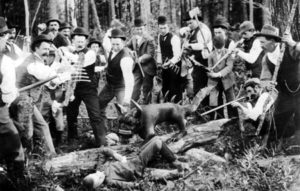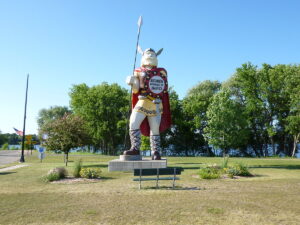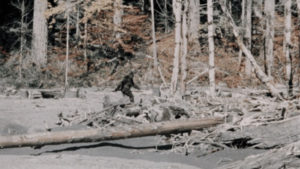
Rhinelander, Wisconsin – Home of the Hodag Stalker – Myth to Money
– Home of the Hodag Stalker TLDR: Population: 7,632 Situation: Town had a downturn because of a lumber mill closing.
Population: 18,118
Situation: From the European to the Modern era, St. Augustine has been a resort town.
Action: This town has utilized this beautiful natural coast and people’s desire for the beach.
Result: A beautiful historic beach town that has thrived through the ages.
In 1513, Juan Ponce de Leon, the governor of Puerto Rico, became the first European to explore the coasts of Florida. He named the peninsula he believed to be “La Florida” and claimed it for the Spanish crown. Several attempts at European colonization were also made before the founding of St. Augustine.
On Easter Sunday, March 27, 1565, Pedro Menéndez saw the eastern coast of Florida. The following year, he named the area Florida, which became known as Pascua Florida. This territory extended north and west from the Gulf of Mexico to encompass most of the North American continent.
On September 6, 1695, the Spanish ships arrived at Matanzas Bay and proceeded to San Agustin. Menéndez immediately started surveying the area to build a fort and protect his settlers while unloading their supplies.
The first fort in Seloy was confirmed through archaeological excavations conducted by Kathleen Deagan. It is believed that the Spanish occupied various Native American structures in the village. It is possible that Menéndez reinforced one of the native structures to create the fort.
Jean Ribault, Laudonnire’s former commander, arrived at Fort Caroline and took over the colony. He ordered his forces to go after St. Augustine despite Laudonnire’S orders.
Ribault was surprised by a powerful storm that lasted for several days. It caused his vessels to break down further south. This allowed Menéndez to march into Fort Caroline, where he would kill almost everyone except for the women and children outnumbered by Spanish forces.
After the French were displaced, Menéndez renamed the fort San Mateo, using it for his purposes. He then encountered the survivors of Ribault near the inlet and executed them. The area has since been referred to as Matanzas, the Spanish word for “Slaughter.”
In 1566, Martnez de Argelles was born at Saint Augustine, making her the first child of European ancestry in the continental United States. This occurred 21 years before the English settled at Roanoke Island and 42 years before the arrival of Santa Fe, New Mexico, and Jamestown.
The town with its Spanish origins would eventually be killed by English pirates led by Francis Drake and lay mostly as a wasteland until the revolutionary war when the British used it as a base of operations. After that, it would shift back to Spanish control again before finally becoming part of the united states. It was briefly part of the confederacy as well.
Henry Flagler is an example of using your wealth to create a better place for all. Flagler was ahead of his time creating opportunities for underprivileged communities time and time again while also promoting fun.
Henry Flagler, a partner in Standard Oil with John D. Rockefeller, moved to St. Augustine in the 1880s. He was instrumental in turning the city into a winter destination for the wealthy northern elite.
Carrre and Hastings, an New York design firm, was hired by Flagler to design several extravagant buildings in Saint Augustine. One of these was the Alcazar Hotel. He also built several churches, including. Grace Methodist, Ancient City Baptist, and the ornate Memorial Presbyterian Church of Venetian architectural style
Architect Flagler commissioned Albert Spalding to design a baseball park for St. Augustine. In the 1880s, the elegant waiters at his hotels established the Ponce de Leon Giants, a professional baseball team composed of African-American players.
In the 1880s, there was no public hospital between Jacksonville and Daytona Beach. In 1888, Henry Flagler invited influential women from St. Augustine to his meeting and offered them a hospital if they would agree to operate it.
One of the oldest commercial attractions in Florida is the Alligator Farm, which dates back to 1893. The other is the Fountain of Young Archaeological Park, which dates back to 1902.
The development of Davis Shores, which was on Anastasia Island, was among the highlights of the 1920s. It was a landfill project by D.P. Davis, it was marketed as “America’s foremost watering place,” and to be reach, it was accessible by the self deemed “most beautiful bridge in Dixie.”
“A visit to St. Augustine, Ponte Vedra Beach & The Beaches is more than just a getaway. It’s a vacation close enough to home but different enough to make you feel a world away. Experience old-world charm, flavorful dining, art and culture, and an abundance of entertainment after dark. Your getaway isn’t faraway!”
A Few of the most notable attractions are:
Fountain of Youth – The Fountain of Youth is located in St. Augustine, and it’s where explorer Poce de Leon discovered the healing powers of the water. You can drink from the fountain and visit other attractions on this 15 acre park.
Castillo de San Marcos National Monument – The Castillo de San Marcos is one of the oldest masonry forts in the U.S. Built after the Spanish militia burned down the nearby forts of St. Augustine. Its construction took over 23 years, and made it from coquina, a local stone.
Fort Matanzas – Fort Matanzas was built to protect from the British sailing through Matanzas Bay. Today, Fort Matanzas has grown to a 300-acre park that features various picnic areas, walking trails, and tidal beaches. The fort is located on Rattlesnake Island, which can be accessed by boat or ferry.
The Colonial Quarter – St. Augustine is the crown jewel of Florida’s history and its Spanish quarter, the centerpiece within it all. With the Colonial Quarter’s Expansion, visitors can now explore the town’s history in four separate eras: the 16th Century First City, Spanish Fortified Town, the 18th Century British Colony, and the 18th Century Spanish Garrison Town. Colonial Quarter has something for everyone. This area has something for everyone, from living history demonstrations and themed restaurants to hands-on activities and period hotels. This area of town is for anyone who has always wanted to experience the colonial lifestyle.
Hotel Ponce de Leon – The elegant Spanish Revival-style structure was named after explorer Juan Ponce de Leon and was built by New York architects Carré and Hastings. It is primarily believed to be their best works. It features a series of large, curved arches and is reminiscent of old Spanish churches.
Hotel Alcazar – The Alcazar was located across King Street from the Ponce. Carrére and Hastings designed both the Ponce and the Alcazar. It was called “The House of Ceasar.” The two-building share many design features, such as brick and terracotta detailing. The Alcazar featured a magnificent garden that connected it to the Ponce de Leon, which in turned connects it to the various other attractions on the ground like swimming pools, exercise areas, and game rooms.
Casa Monica – The elegant Spanish-Moorish style of the Casa Monica, Later called the Cordova Hotel, reflects the style of the time. Its suites were equipped with gaslights, electric bells, and all the top end amenities of the day.
You might be reading this right now and thinking, well, I do not have a 450 year old town that a billionaire invested in hundred of years ago to make it a tourist town. From everyone in the US, this is true. But did you know that most of the old quarter in St. Augustine was gone?
In 1965 the town with the Florida government formed the “Historic St. Augustine Preservation Board” and was formed to reconstruct 36 buildings to their historic appearance. They reconstructed other historic properties as well, creating the town we recognize today.
Yes, they had many resources to build off of like Selene Deon selling ice cream on the apprentice. It was easier to get up and running but ultimately it was the effort put into the situation that returned results.
Catch the latest from Creative City Developments

– Home of the Hodag Stalker TLDR: Population: 7,632 Situation: Town had a downturn because of a lumber mill closing.

Alexandria, MN – The Big Ole & The Runestone TLDR: Situation: Alexandria, MN, a city with a unique Scandinavian heritage,

– The Bigfoot Capital of the World TLDR: Population: 1,700 Situation: Small town looking to draw tourism away from California’s coasts.